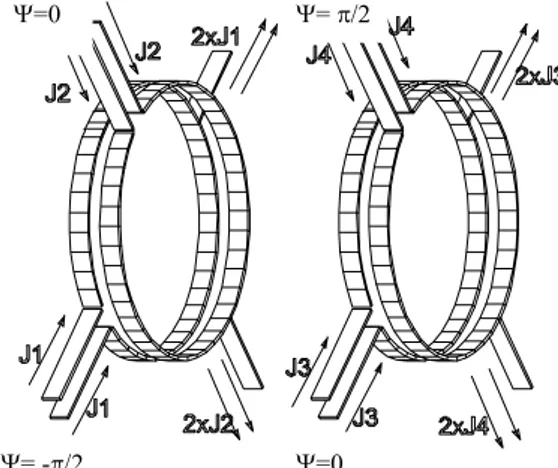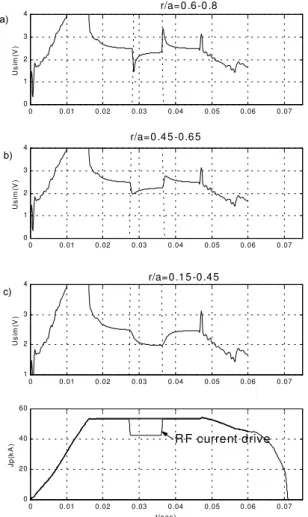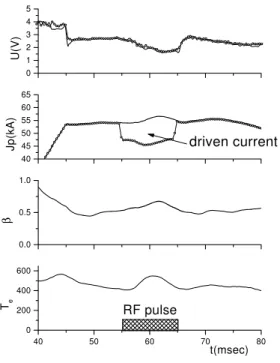The Analysis of Alfven Wave Current
Drive and Plasma Heating in TCABR Tokamak
L.F. Ruhko,E.A. Lerhe, R.M.O. Galv~ao,A.G. Elmov,I.C.Nasimento,
W.P. de Sa,E. Sanada, J.I. Elizondo,A.A. Ferreira, E.A. Saettone,
J.H.F. Severo, V. Bellintani,and O.N. Usuriaga
Institutode Fsia,UniversidadedeS~aoPaulo,
CaixaPostal66318, CEP05315-970, S~aoPaulo,Brasil
Reeivedon26June,2001
TheresultsofexperimentsonAlfvenwaveurrentdriveandplasmaheatingintheTCABRtokamak
areanalyzedwiththehelpofanumerialodeforsimulationofthediusionofthetoroidaleletri
eld. Itpermitstondradialdistributionsofplasmaurrentdensityandondutivity,whihmath
theexperimentallymeasuredtotalplasmaurrentandloopvoltagehanges,andthustostudythe
performaneoftheRFsystemduring Alfvenwaveplasmaheatingandurrentdriveexperiments.
RegimeswitheÆientRFpowerinput inTCABRhavebeenanalyzedandrevealedthepossibility
ofnonindutiveurrent generationwithmagnitudesup to8kA.Theinreaseofplasma energy
ontentduetoRFpowerinputisonsistentwiththediamagnetimeasurements.
I Introdution
Theknowledgeofthemagnitudeandradialposition
ofnonindutivelydriventoroidalurrentinatokamak
plasma,whihisgeneratedbyAlfvenwaves,isofgreat
importane both for optimization of theurrentdrive
sheme itself and for tokamak operation. The most
ommonly usedmethod fordetermination ofthe
mag-nitude ofthe nonindutivelydrivenurrentonsistsof
the analysis of theloopvoltage response to the
appli-ationofanonindutivedrivingfore. Ifthetotal
ur-rent is maintained onstant and a stationary state is
obtained,thenthemagnitudeofthedrivenurrentan
be easily alulated through the loop voltage drop at
the plasma boundary. More ompliated alulations
are neessary in the ase when stationary onditions
arenotahieved.
The problem of toroidal urrent diusion in the
preseneofexternalnon-Ohmiurrentdrivewas
ana-lyzed in the review [1℄. It was pointed outthere that
harateristi time sale of plasma urrent build-up,
whihisonnetedwithtransformationoftheenergyof
externalnonindutiveurrentsoureintotheenergyof
thepoloidalmagnetieldoftheplasmaolumn,anbe
dividedintwoparts,
ext and
int ,
int <
ext
,in
aor-dane with the division ofthe totalpoloidal magneti
eld energyW
t
in twopartsW
t =W
int +W
ext ,where
W
int
is theenergyof themagneti eld inside plasma
andW istheenergyofthemagnetieldoutsidethe
plasma olumn. Usually W
int
amounts to 25-30% of
W
t
. Theharateristitimesaleanbedenedasthe
ratioofthemagnetieldenergy,W
t =
LI 2
2
,to ohmi
power, R I 2
, whih is dissipated in plasma due to the
ow of the eletri urrent that reates this magneti
eld. Thistimeorrespondstothe L
R
time ofan
ele-trialshemewithresistorRandindutorLonneted
inseries. Thesmallertimesale
int
orrespondstothe
time that is neessaryfor termination of all transient
proessesinsideplasmaolumn,thatisduringthistime
the rebuilding of the prole of the plasma urrent is
ompletedandthesubsequenthangesoftotalplasma
urrentIareaomplishedwithonservationofthe
ur-rentprolej(r). Thelargertimesale
ext
orresponds
tothe timewhih isneessaryforthe totalurrent to
reah a stationary value. In the framework of a 0-D
numerialmodel,inwhihtheplasmaisrepresentedas
resistaneandindutaneonnetedinseries,onlythe
proesseswith harateristi time sales
ext an
be analyzed. The proess of toroidal urrent
redistri-butionwithatimesale
int
hastobeanalyzedby
solvingan1-Dplasmatransportmodel.
Currentdiusionandtoroidaleletrieldresponse
tonon-Ohmiurrentdriveintheframeworkofa
sim-plied1-D model was studied in [2℄. In this paper, a
model onsistingof aylindrial plasmaolumn in an
uniformaxialmagnetieldwasonsidered,theplasma
quantities and eletri eld were assumed to be both
simplia-ity was taken as known, rather than self-onsistently
foundfromtheompletesetoftransportequations. In
order toinlude theeets that dependon
ondutiv-ityproles,analytialsolutionswereomplementedby
numeriallyfoundeigenfuntionsofdiusionboundary
problem. These resultswere usedforinterpretationof
experimentaldata onAlfvenwaveurrentdriveinthe
PHAEDRUS-T tokamak [3℄and have demonstrated a
orretdesriptionoftheevolutionoftheeletrield.
They haveshown also that the time behaviorof loop
voltage response to appliation of non-Ohmi urrent
driveanbeusedto ndouttheradialpositionofthe
nonindutively-drivenurrent.
Inthis paperwepresentanumerialodethat has
beendevelopedspeiallyforanalysisofthe
experimen-taldataonnonindutive-urrentdrivebyAlfvenwaves
in the TCABR tokamak [4℄. We use a 1-D plasma
model similar to [2℄. This ompletely numerial
pro-edure forsolutionthe diusionevolutionforthe
ele-tri eld has no omputational limitations on plasma
prolesand temporal behaviorof thedriving fore. It
permits to nd radial distributions of plasma urrent
densityandondutivity,whihmath the
experimen-tally measured total plasma urrent and loop voltage
hanges, andthustostudy theperformaneof theRF
system during Alfven wave plasma heating and
ur-rentdriveexperiments. DierentregimeswitheÆient
RF power input in TCABR have been analyzed and
revealedthepossibilityofnonindutiveurrent
genera-tionwithmagnitudesupto8kA.
II Numerial model
Weusetheusualpowerbalaneassumptionthatall
plasmaparametersdepend ontimeandononespatial
oordinate,whihdeterminestheirularmagneti
sur-faes. Thatis,inthefollowingallloalquantities suh
as plasma temperature, urrent density, input power
et., orrespond to averaged values on magneti
sur-faes. Further simpliations on the numerial
alu-lations are made assuming that the temperature and
ondutivity donotome self-onsistently from power
balane equations, but an be modied to t
experi-mentaldataoranbepredenedfuntionsoftimeand
radiusT(r;t)and(r;t).
The plasma urrent response to nonindutive
ur-rot !
H = 4
!
E + 4
!
j
d
(1)
and
rot !
E = 1
!
H
t
(2)
HereweassumethatthetoroidalomponentofOhm's
lawhastheform
j=j
d
+(r;t)E (3)
where j,j
d
andE areaxial totalurrentdensity,
non-indutivelydrivenurrentdensity,andeletrield,
re-spetively. From these equations, weobtainthe
diu-sionequationfortheeletrield:
E =
4
2
(
t E+
E
t +
j
d
t
) (4)
Afterthesubstitutionsr=xa,
2
4a 2
=k,andj
d =S,
thefollowinginhomogeneousdiusionequationfollows
E
t
=k(x;t) 1
x
x (x
E
x )
1
(x;t)
(x;t)
t E
S
t 1
(x;t)
(x;t)
t
S (5)
Here weintroduedthe "eetive"eld S(x;t), whih
orresponds tononindutiveurrentdrivefore andis
determined by the input RF powerand urrent drive
eÆieny.
Thisequationhastobesolvedwith boundary
on-ditions
E
x
x=0 =0;
E
x
x=1 =
2
2
I
p
t
(6)
and initial ondition E(x;0) = '(x), where I
p is the
totalplasmaurrent.
TheboundaryvalueproblemEq.5-6issolvedusing
theCrank-Niolsonnumerialsheme,whihgiveshigh
aurayandisunonditionallystable. Somedetailsof
numerialshemearegivenbelow.
Asrststep,wedividethespatialinterval0x1
into N 1 elements h by N points i = 1;2:::N and
h= 1
N 1
; then x
i
=(i 1)=h. In Eq.5wedisretizy
spae andtime in inrementsofhand , respetively,
and obtain, for the inner points 2 i N 1, the
E n+1 i E n i = D i h 2 " E n i+1 +E n i 1 2E n i + h E n i+1 E n i 1 2x i # E n i n i n+1 i n i S n i n i n+1 i n i S n+1 i S n i : (7) Here E n i =E(x i ;t n ),D i =k(x i ;t n ), n i =(x i ;t n ),S n i =S(x i ;t n
):Aftersubstitutionx
i
=(i 1)h,weget
E n+1 i = E n i + D i h 2 " E n i+1 + E n i+1
2(i 1)
2+ h 2 D i n+1 i n i n i ! E n i +E n i 1 E n i 1
2(i 1) # S n+1 +S n ; (8)
Forouterpointsi=1andi =N, weuse boundaryonditions atx =0 ( E
x
x=0
=0) and atx =1( E x x=1 = 2 2 Jp t
)andobtaintheadditionalrelations
E n 1 =E n 2 (9) E n N =E n N 1 +h 2 2 J n+1 p J n+1 p (10) E n+1 i =E n i + i i+1 X
k =i 1 Z ik E n k S n+1 S n (11) Here i = Di h 2
andtheoperatorZ
ik
hasthefollowingtridiagonalstruture
Z ik =Æ i;k 1 1 1
2(i 1) +Æ i;k 2 1 i n+1 i n i n i ! +Æ i;k+1 1+ 1
2(i 1)
: (12)
TheoperatorelementsZ
1;k andZ
N;k
havetobedeterminedthroughtheboundaryonditionsatx=0andx=1:
E x x=0
= 0 =) E
n 1 =E n 2 E x x=1 = 2 2 J p t
=) E
n N =E n N 1 +h 2 2 J n+1 p J n+1 p (13)
Nowitispossibletodenetheoperator
i;k
for 1iN:
E n+1 i = N X k =1 " i;k E n k +Æ i;k Æ k ;N h 2 J n+1 p J n p # S n+1 k S n k (14) where i;k =Æ i;k +1 i 1 1
2(k 1) +Æ i;k 1 2 i n+1 i n i n i ! +Æ i;k 1 i 1+ 1 2(k 1) (15)
Eq.14representsexpliitFTCSnumerialshemeforthegivenpartialdierentialequation(PDE).Inthenext
stepweseparatetimeandspatial dependeniesandexpressEq.14intheform
E n+1 i =E n i + X k H i;k E n k +R n+1 i R n i (16) where R n i =Æ i;N h 2 2J n p S n i
is aknownmatrix, whih is determined by the driving urrent soureand by total
urrentevolution,and
E n+1
=(I+H)E n
+R n+1
R n
(18)
whereI istheunitaryoperator.
Now we apply the operator Hto the future value
E n+1
E n+1
=E n
+HE n+1
+R n+1
R n
(19)
and,solvingforE n+1
,weobtainimpliitFTCSsheme
forthegivenpartialdierentialequation
E n+1
=(I H) 1
E n
+R n+1
R n
: (20)
AfterndingtheaverageofEq.18andEq.20and
solv-ingforE n+1
,wenallygettheCrank-Niolsonsheme
forsolvingourpartialdierentialproblem
E n+1
=
I 1
2 H
1
I+ 1
2 H
E n
+R n+1
R n
(21)
This sheme was used in thenumerial simulationsof
theeletrielddiusion. Thenumerialproedure
in-ludedreadingtheexperimentaldataonthemeasured
plasma urrent, whih were stored by the data
aqui-sition system of TCABR. Then, after dierentiation,
these data were used as boundary onditions for the
numerialode(Eq.6). Afterthe numerialsolutionof
equation Eq.21,weobtainthe evolutionof radial
pro-leoftheplasmaurrentdensityandofthelongitudinal
eletrield duringthedisharge. Bothohmiheating
and RFheating and urrentdrivephases anbe
ana-lyzed. The numerial analysis hasbeen performed in
thefollowingorder.
1. Readingexperimentaldatasetfortheplasma
ur-rent, whih was obtained during a plasma
dis-hargein TCABR;
2. Smoothingof the experimental dataand nding
thederivativeoftheplasmaurrent;
3. Numerial solution of partial dierential
equa-tions for eletri eld diusion with obtained
boundaryonditionsand ndingthetime
evolu-tionofalulatedloopvoltage;
4. Analysis of simulation results and, if neessary,
repetition of alulations with modied plasma
parameters, whih inlude eletron temperature
prole and nonindutivedriving fore, until
rea-sonable tting to experimentally measured loop
voltagedataisobtained.
Asitwasshownin[2℄,[3℄theanalysisofloopvoltage
responseto nonindutiveplasmaurrentdrivepermits
tondboththeamplitudeofthedrivenurrentandits
harge with Alfven wave
heating and urrent drive
III.1 Experimental setup
Thebasi regimes forAlfven wave plasmaheating
and urrent drive experiments had following
parame-ters: toroidalmagnetield B
0
=1.1Tonaxis,major
plasma radius R = 0.61m, minor radius a= 0.18 m,
plasma urrent I
P
= 70 to 95 kA, edge safety fator
q(a) ' 3.5 to 5.5, line averagedplasmadensityin the
rangehn
e
i=(0.9to3.5)10 19
m 3
,workinggas
hydro-gen.
Theuseddiagnostitoolsinludeonventional
ele-trotehnial measurements of the loop voltage U,
plasma urrent I
P
, plasma olumn shift (dR , dZ),
plasmaenergyontenthnTibydiamagnetisignaland
plasma equilibrium parameters, fast bolometer
mea-surementsof plasmalosses, and optialmeasurements
ofvisibleradiationintensity. Thelineaveragedplasma
density wasmeasured bymulti-hannel mirowave
in-terferometer. Theionsaturationurrentinthelimiter
shadowwasmonitoredbyamovableLangmuirprobe.
The omplete desription of the RF system of
TCABR tokamak is given in [4℄. In the present
ex-perimentsonlyonemoduleoftheAlfvenwaveantenna
systemhas been used. It waspoweredbythe4-phase
RFgenerator,whihhasnominaloutput power e
P 1
MW in the frequeny range f = 3 to 5.5 MHz. It
provided RF pulses with duration 10 mse. The
shemeofantennastrapsfeedingis showninFig.1.
<
<
S
<
<
S
Thespatialspetrumof theexitedRFeld(wave
numbers M;N) and its heliity was ontrolled by the
phase ofRFfeeding urrents. Intheourseof RF
ex-periments,dierentantennaongurationsweretested.
As it isseenin Fig.1,the antennamodule ofTCABR
hasfour pairsofhalfloops, whih anbefed
indepen-dentlybytheRFurrents. ItallowstoexitetheAlfven
waveswithdierentmodestruture(M;N)andto
hoosethedesiredheliityofexitedwave(MN>0
orMN<0). IntheFig.2thereareshown
shemati-allythediretionoftoroidalmagnetieldB
T
,plasma
ohmiurrentIpandthewavevetor !
k,whihare
typ-ialfortokamakTCABR.Thelinedeterminesthe
posi-tionoftheRFwavefront,whihissetbyphasingofthe
antennafeedingurrents. Forthepresentase,the
he-liityoftheexitedwaveisnegative(MN<0). The
antennaurrentfeedingforthisaseisshowninFig.1.
Theoretial alulations predit more eÆient Alfven
waveheatingforthisasebeausetheprojetionofthe
wavevetoron the totalmagneti eld k
==
haslarger
valuethanintheaseofpositiveheliity(MN>0).
This resultappearedbeauseofthediretionofohmi
urrentin theTCABR tokamak,whih is opposite to
main toroidalmagnetield.
T
B
&
I
P
&
θ
ˆ
z
ˆ
B
&
k
&
⊥
k
//
k
const
m
z
k
z
+
θ
=
Figure2. ShematipresentationoftokamakTCABR
mag-netieldstrutureandantennaheliityhoosing.
III.2 Analysis of antenna phasing
inu-ene on exited wave spetrum
The position r
S
of the zone where the RF
power deposition ours, during Alfven wave
exi-tation, is determined by the wave dispersion
re-lation ! = k
== (r
S )C
A (r
S )
p
(1 ! 2
=! 2
i
). Here
C
A (r
S ) =
B
p
4(r
S )
is the Alfven veloity and k
== =
1
R
n+ m
q(r
S )
is the parallel omponent of wave
ve-systemharateristisaninuene r
S .
TheompleteantennasystemofTCABRtokamak,
whihhastobeomposedoffourantennamodules,
en-sures seletive mode exitation and makes it possible
to ontrol the radial prole of the RF power
deposi-tion. This advantageof Alfvenwaveheating and
ur-rentdrivesheme anbeused forplasmaonnement
andstabilityontrolin theinvestigationsthat are
ar-riedoutintheprogramsofadvanedtokamakonept.
The utilization of only one antenna module does not
permit to exiteamonohromati spatial spetrum of
Alfvenmodesandtorealizeompletelytheadvantages
ofthisplasmaRFheatingsheme. Inthisase,
dier-entmodesanbeexitedsimultaneouslyandtheyan
deposit RFpowerindierentplasmaradialregions.
-10
-5
0
5
10
-4
-2
0
2
4
0
0.5
1
1.5
N
M
Za(Ohm)
-10
-5
0
5
10
-4
-2
0
2
4
0
0.02
0.04
0.06
0.08
0.1
N
M
Za(Ohm)
D
E
Figure3.Wavespetrumofantennaimpedaneforone
an-tennamodule: a) four pairs of half-loops are powered by
RFurrentswith =2phasing, b)onepairof half-loopsis
powered.
TheresultingradialproleofRFpowerdeposition
depends strongly on antenna urrent phasing. With
orretly hosen antenna urrent phasing, a rather
de-theexitedmodestrutureisshowninFig.3a. Itisseen
that themaximumRF powerdeposition goesthrough
exitationofmodesgroupedaroundM= 1;N =2;3.
Theydeposittheirenergyindeterminedplasmaradial
positionsandpermittogenerateanonindutiveurrent
inthediretionofplasmaohmiurrentandtohange
the radial prole of safety fator q(r). For
ompari-son,theimpedanewavespetrum,whihisexitedby
the antennamodule when only one pair of half-loops
is powered,is shown in the Fig.3b. Inthis asemany
plasmamodesareexitedsimultaneouslyanditis
diÆ-ult toontrolradialposition ofthepowerdeposition
zone.
Thedependene ofradialdistributionofdissipated
RFpoweronplasmaentral densityforantenna
mod-ule ofTCABR is presented in Fig.4. The alulations
havebeenarriedoutwiththehelpofaMHDnumerial
ode[4℄[5℄foroneantennamodulewithurrent
phas-ing,whihisshownin Fig.1,andwhihorrespondsto
exitationofawavewithnegativeheliity(MN <0).
It is seenthat there are regionsof plasma parameters
whih permit eÆient plasma heating with RF power
depositionneartheplasmaolumnenter.
0
1
2
3
4
0
0.2
0.4
0.6
0.8
1
0
0.1
0.2
0.3
0.4
0.5
0.6
n
e
x10
19
m
-3
r/a
f= 3.5MHz
a
3 D X
Figure4.TheradialdependeneofRFpowerinputas
fun-tionofplasmaentraldensityn
e(0) .
III.3 Analysis of loop voltage hanges
during RF power input in tokamak
plasma
For the analysis, we have hosen the plasma
dis-harge shot #4893 in the TCABR tokamak , where
eÆientantenna-plasmaouplingwasobserved. The
traesofsomeexperimentalsignalsareshowninFig.5.
The Alfven waveantennae were powered at time
mo-ment t
1
= 55 mse, and the RF pulse duration was
10 mse, approximately. The details of the disharge
areshownin Fig.6.It isseenthat in theourseofthe
fallsdown. Thiseetanbeexplainedbothbyan
ele-trontemperatureinreasedue to Alfvenwaveheating
and by nonindutive urrent drive. In order to
sepa-ratethesetwoeets,wehavetoarryouttheanalysis
of theloopvoltagedropand omparetheresultswith
theindependentmeasurementsofplasmatemperature
evolution.
7&$%5
6+27
9
/223
9
,
3
N$
5) 3XOVH
Q
H
P
3RZHU /RVVN:
E
'LDP
WLPHPV
Figure5. Plasmadisharge#4893inTCABRtokamak.
β
Figure 6. Details of the signals U, IP, d of plasma
dis-harge#4893.
As it was shown in [2℄, the harater of the loop
voltage evolution in atokamak disharge during
non-indutiveurrentdrivedepends ontheradialposition
oftheresonanezone,wherethedrivenurrentis
gen-erated. The resultsof loop voltage reonstrution for
dierentradialpositionsoftheRFdrivenurrentx= r
a
in TCABR areshownin Fig.7. Heretheoriginofaxis
voltage response is quite dierent for x = 0:6 to 0:8
(Fig.7a), x = 0:45 to 0:65 (Fig.7b), x = 0:15 to 0:45
(Fig.7), in spite of thefat that thewaveformof RF
drivenurrentwasthesame. Thisphenomenonanbe
used as diagnosti tool for nding the exited Alfven
wave spetrum, whih is responsible for the observed
urrentdrive. Thisproedurehasto inlude
deompo-sitionoftheexperimentallyobtainedvoltagedropina
seriesofbasiloopvoltageresponses,whiharesimilar
to onesshownin Fig.7.
0
0.01
0.02
0.03
0.04
0.05
0.06
0.07
0
1
2
3
4
Us
im
(V
)
0
0.05
0.1
0.15
0
20
40
60
80
100
Jp
(k
A
)
r/a=0 .6 -0 .8
0
0.01
0.02
0.03
0.04
0.05
0.06
0.07
0
1
2
3
4
Us
im
(V
)
0
0.01
0.02
0.03
0.04
0.05
0.06
0.07
0
20
40
60
Jp
(k
A
)
r/a=0 .4 5 -0 .6 5
0
0.01
0.02
0.03
0.04
0.05
0.06
0.07
1
2
3
4
Us
im
(V
)
0
0.01
0.02
0.03
0.04
0.05
0.06
0.07
0
20
40
60
Jp
(k
A
)
t(s ec )
r/a=0 .1 5 -0 .4 5
R F current drive
D
E
F
Figure7. Numerialreonstrutionofloopvoltageresponse
to nonindutive urrent drive for dierent radial positions
ofRFpowerinputzone.
In our ase the shape of the experimentally
mea-suredloopvoltageurvehasbeenttedtotheshapeof
the reonstrutedloop voltage urves,whihwere
al-ulated for dierentradialpositions ofdrivenurrent.
Theinitialdatafornumerialproedurewereobtained
from the experimental data, whih are stored in the
TCABR database. This analysisshowsthatthemain
part of the RF driven urrent, whih an have been
generated in plasmadisharge#4893, owsin the
in-nerplasmaregions.
At the next step of our analysis, we suppose that
talmagnitudeoftheloopvoltagedropisduetoplasma
eletronheating. Theresultsofloopvoltage
reonstru-tionforthisaseareshowninFig.8. Itisseenthatthe
reonstruted loop voltage urve, whih is marked by
irles, ts the experimental urve (solid line) rather
well. The plasma ondutivity was alulated by the
SpitzerformulawithZ
eff
=4. Theeletron
tempera-ture,whih was used in ttingproedure,isshown at
thebottom of Fig.8. It isseenthat for reasonable
ex-planationoftheobservedloopvoltagedropwehaveto
assumethattheeletrontemperatureinreasesdue to
theAlfven waveheating, i.e.,T
e
'180 200eV.At
thesametimedataofdiamagnetimeasurements(in
Fig.8)showsmallervalues of T
e
. Forelimination of
thisdisrepany,wehavetorelatepartofloopvoltage
dropto nonindutiveurrentgeneration.
40
50
60
70
80
0
200
400
600
RF pulse
T
e
t(msec)
0.0
0.5
1.0
β
40
50
60
Jp(
k
A)
0
1
2
3
4
5
U(
V
)
Figure8.Loopvoltagereonstrutionforshot#4893
with-outRFurrentdrive.
Now we assume that some nonidutive urrent is
driven by Alfven waves in inner plasma regions, and
adjustthereonstrutedloopvoltagetothisase. The
result of the simulation is shown in Fig.9. It is seen
from the plasma urrent urves that during RF pulse
somepartofohmiurrentissubstitutedbyRFdriven
urrent, whih amounts to I
CD
' 8 kA. The
reon-strutedloopvoltagenowtstheexperimentally
mea-sured values with a smaller plasma temperature
in-reaseT
e
150eV andit better orrespondsto the
diamagnetimeasurements. InthisexperimenttheRF
powerthathasbeendissipatedintheplasmaamounted
toavalue e
P
RF
80kW,andtheeÆienyofRF
ur-rent drivean be estimated as = ICD
e P
RF
DRUS - T tokamak, at smaller plasma densities [3℄.
Rather higheÆieny of urrentdrivein TCABR an
beonnetedwithgenerationofurrentininnerplasma
regions, where the eet of trapped partiles plays
smaller role. Further experimental studies with more
auratediagnosti toolsareneessaryfor veriation
oftheseresults.
40
50
60
70
80
0
200
400
600
RF pulse
T
e
t(msec)
0.0
0.5
1.0
β
40
45
50
55
60
65
driven current
Jp(kA)
0
1
2
3
4
5
U(V)
Figure9. Loopvoltagereonstrutionforshot#4893with
RFurrentdriveinluded.
Thealulatedplasmaurrentproleforthese
sim-ulations is shown in Fig.10. It is worthwhile to note
that someevidene ofurrentprolemodiationan
befoundin theMHDativitymodiation,whihwas
registeredby Mirnov probesduring Alfvenwave
exi-tation.
IV Conlusion
IntheourseofAlfvenwaveexperimentsinTCABR
tokamak the regime of eetive antenna- plasma
ou-plingwasfoundwithRFpowerinput e
P
RF
>80kW.
30
35
40
45
50
55
60
0
0.2
0.4
0.6
0.8
1
0
50
100
150
200
250
300
350
400
r/a
t(msec)
j(A/cm
2
)
Figure10. Currentproleevolutioninplasmashot#4893
withAlfvenwaveurrentdrive.
Theresultsofexperiments onAlfvenwaveurrent
driveandplasmaheating havebeenanalyzedwiththe
helpofnumerialodeforsimulationoftoroidaleletri
eld diusion.
Thenumerialreonstrutionoftheloopvoltage
re-sponsetotheRFpowerinputsuggeststhepossibilityof
RFurrentdriveI
CD
'8kAwithaneÆieny '0.1
A/W,howevermoreauratediagnostisareneessary.
Aknowledgement
ThisworkhasbeensupportedbyConselhoNaional
dePesquisaeDesenvolvimentoCient
ioeTenologio,
Funda~ao de Amparo a Pesquisa do Estado de S~ao
PauloeFinaniadoradeEstudoseProjetos,Brasil.
Referenes
[1℄ Ya. I. Kolesnihenko, V.V. Parail, G.V. Pereverzev,
Rev. Plasma Phys. edited by Kadomtsev B.B.,
Con-sultantsBureau,NewYork,17,3,1990.
[2℄ C.Litwin,Phys.Plasmas2,4542 (1995).
[3℄ C. Litwin, N. Hershkowitz, S. Wukith, T. Intrator,
M. Vuovi,D. Brouhous, R.Breun,and M.Harper,
Phys.Plasmas2,4551 (1995).
[4℄ L.F. Ruhko, E. Ozono, R.M.O. Galv~ao, I.C.
Nasi-mento,F.T. Degasperi,E.Lerhe,FusionEngineering
andDesign43,15(1998).
[5℄ L.F.Ruhko,M.C. Andrade,R.M.O.Galv~ao. Nulear




